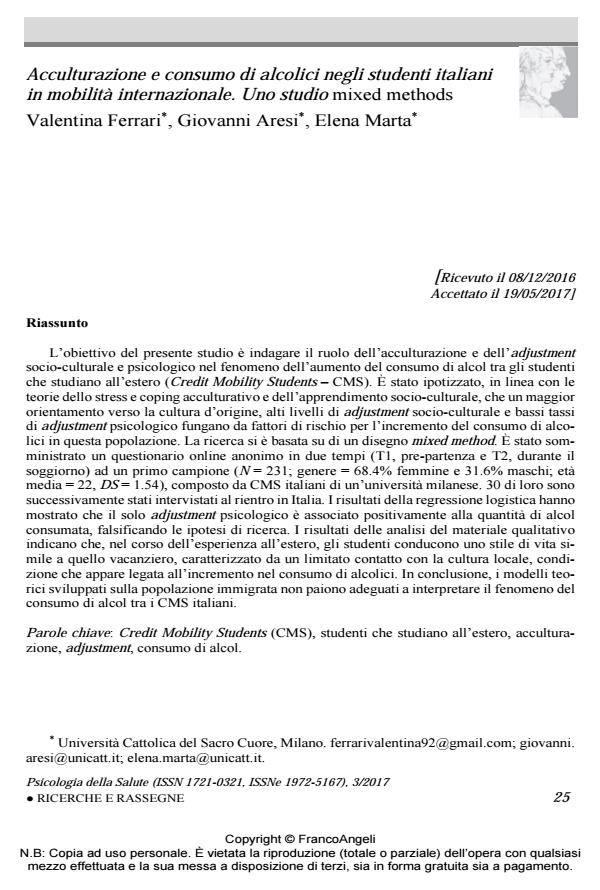Acculturation and alcohol consumption among Italian credit mobility students. A longitudinal mixed method study
Journal title PSICOLOGIA DELLA SALUTE
Author/s Valentina Ferrari, Giovanni Aresi, Elena Marta
Publishing Year 2017 Issue 2017/3
Language Italian Pages 27 P. 25-51 File size 306 KB
DOI 10.3280/PDS2017-003002
DOI is like a bar code for intellectual property: to have more infomation
click here
Below, you can see the article first page
If you want to buy this article in PDF format, you can do it, following the instructions to buy download credits

FrancoAngeli is member of Publishers International Linking Association, Inc (PILA), a not-for-profit association which run the CrossRef service enabling links to and from online scholarly content.
The aim of the present study is to investigate the role of acculturation and socio-cultural and psychological adjustment in the alcohol consumption phenomenon among students in international mobility (Credit Mobility Students ‒ CMS). It has been suggested, consistently with acculturative stress and coping theory and socio-cultural learning theory, that acculturative orientation towards the country of origins, high level of socio-cultural adjustment and lower rates of psychological adjustment could work as risk factors for alcohol consumption increase among this population. The study adopted a mixed method design. An online anonymous questionnaire was submitted in two times (T1 pre-departure and T2, during the so-journ) to a first sample (N = 231; gender = 68.4% female e 31.6% male; average age = 22, SD = 1.54), composed of Italian Credit Mobility Students from a Milan university. 30 of them were also interviewed after their return. Logistic regression’s results showed that psy-chological adjustment was the only variable significantly and positively associated with the amount of alcohol consumed, falsifying the hypothesis. Qualitative results suggested that participants led a lifestyle similar to holiday-makers, featured by limited contact with the local culture, condition that seems to be connected with alcohol consumption rates. In conclusion, the existing theoretical frameworks developed on immigrant population resulted inadequate to explain the drinking phenomenon among Italian CMS.
Keywords: Credit Mobility Students (CMS), study abroad students, acculturation, adjustment, alcohol consumption.
- Analysing change among study abroad students. A novel application of the person-centred approach to alcohol use patterns Giovanni Aresi, Angela Sorgente, Simon C. Moore, Elena Marta, in International Journal of Intercultural Relations /2021 pp.220
DOI: 10.1016/j.ijintrel.2021.04.006 - The Palgrave Handbook of Youth Mobility and Educational Migration Giovanni Aresi, Elena Marta, Simon C. Moore, pp.441 (ISBN:978-3-030-99446-4)
- The Palgrave Handbook of Youth Mobility and Educational Migration Giovanni Aresi, Elena Marta, Simon C. Moore, pp.427 (ISBN:978-3-030-64234-1)
Valentina Ferrari, Giovanni Aresi, Elena Marta, Acculturazione e consumo di alcolici negli studenti italiani in mobilità internazionale. Uno studio mixed methods in "PSICOLOGIA DELLA SALUTE" 3/2017, pp 25-51, DOI: 10.3280/PDS2017-003002